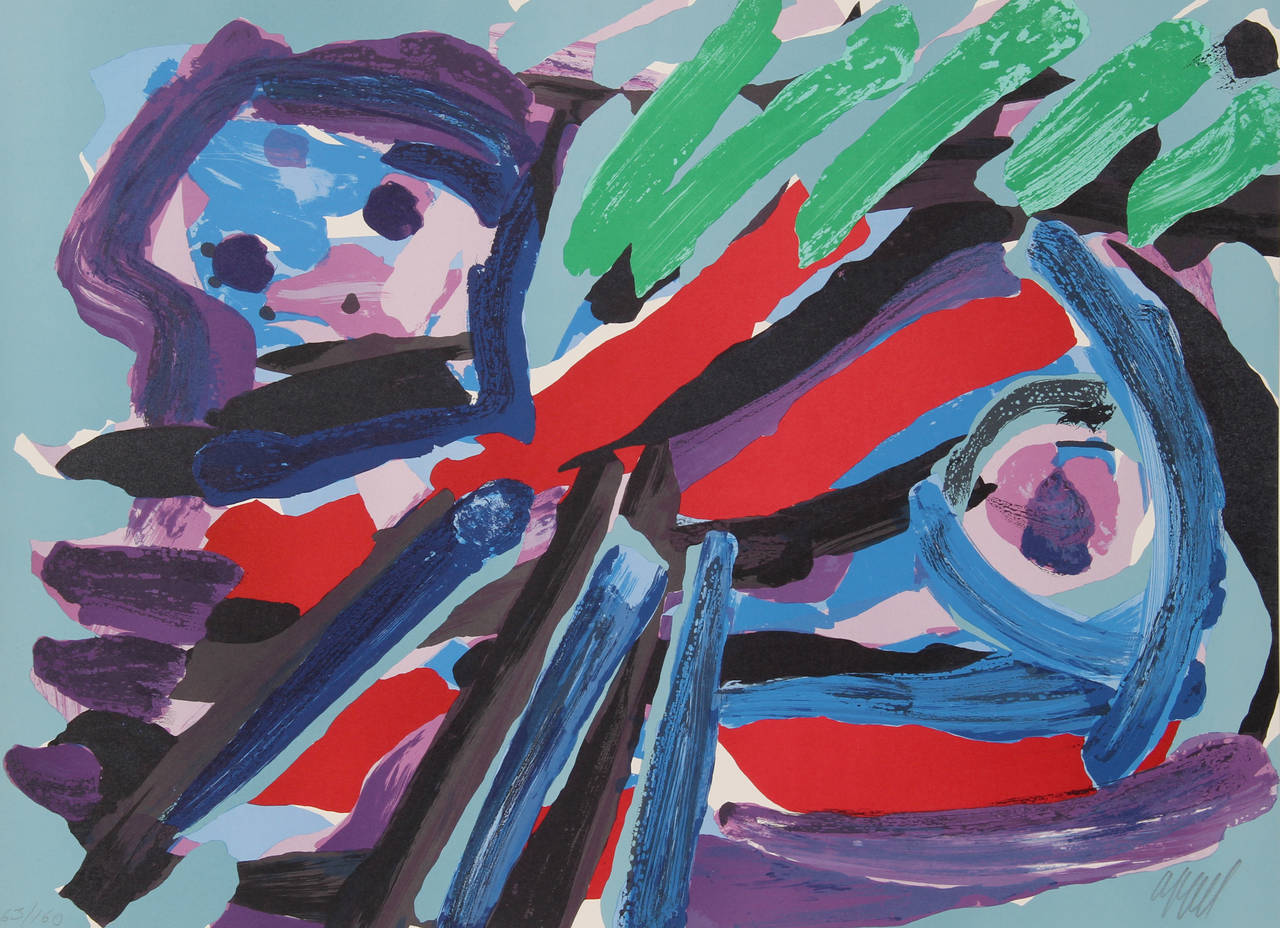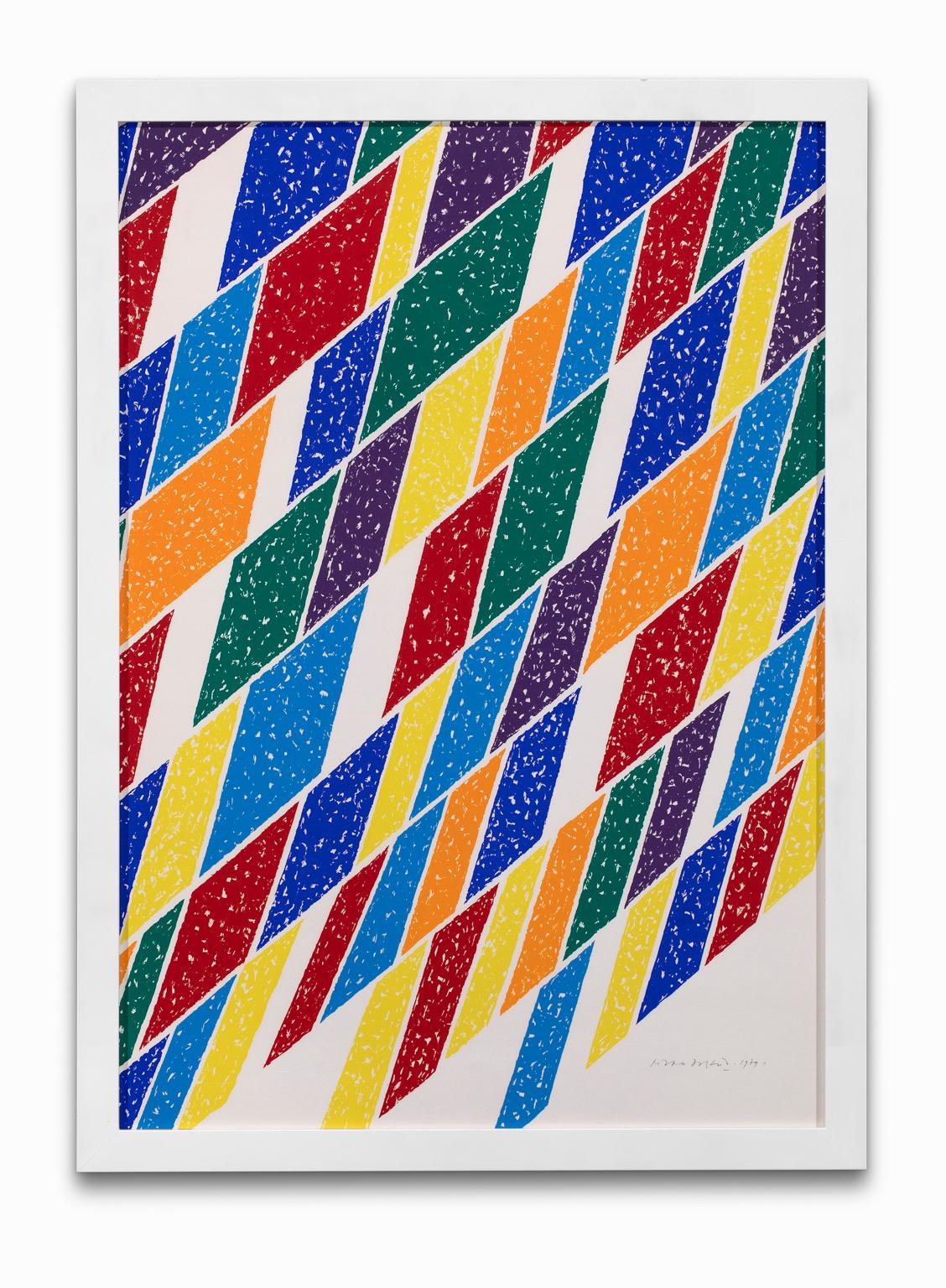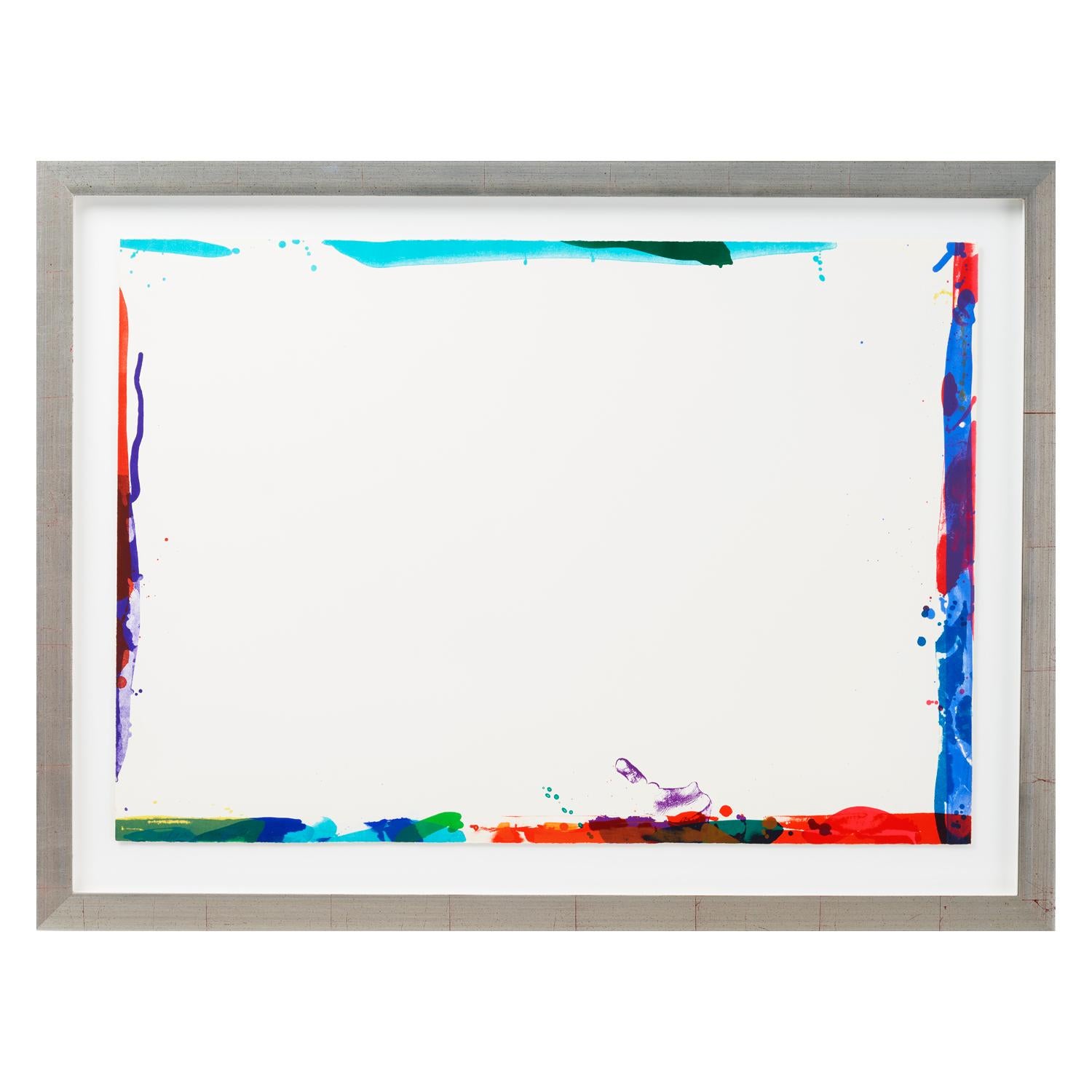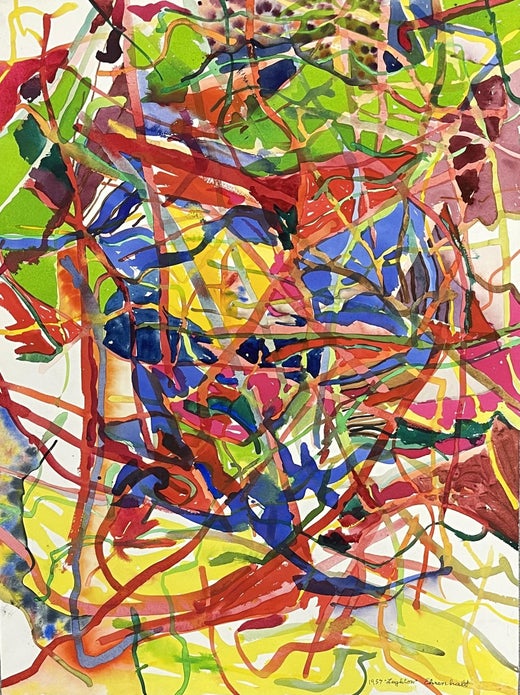Amaranth EhrenhaltColor Embossed Lithograph Print New York Abstract Expressionist Woman Artist
About the Item
- Creator:Amaranth Ehrenhalt (1936, American)
- Dimensions:Height: 15.75 in (40.01 cm)Width: 12 in (30.48 cm)
- Medium:
- Movement & Style:
- Period:
- Condition:
- Gallery Location:Surfside, FL
- Reference Number:1stDibs: LU3825527962
Amaranth Ehrenhalt
When multidisciplinary Abstract Expressionist artist Amaranth Ehrenhalt first moved from Philadelphia to New York City in the 1950s she unintentionally lived out the “starving artist” lifestyle. She made her paintings on the floor, but not in order to replicate the technique attributed to American painter Jackson Pollock. Owing to her modest financial situation, she simply didn't own a table.
Ehrenhalt graduated from the University of Pennsylvania in 1951 and attended a weekly course at the Barnes Foundation. There, she basked in the owner's large Parisian art collection and became deeply enamored with French artwork. It should come as no surprise that when a friend offered to trade a round trip to Paris for a portrait, Ehrenhalt jumped at the opportunity. Dutch-American painter Willem de Kooning — a fellow New Yorker at the time — invited her to have dinner upon her return, but after experiencing the Parisian art scene, she canceled her return trip and the two never shared that dinner. Ehrenhalt forged connections with Joan Mitchell, Alberto Giacometti and Yves Klein in the French capital, and remained in the country for over 40 years.
In her later years, Ehrenhalt returned to New York. She often traveled with her son, enraging the security guards at many of the world’s finest museums. From the Louvre in Paris to the Metropolitan Museum of Art in New York, her son, Caradoc remembers guards running and shouting at the sight of Ehrenhalt leaning a nose-length away from the art, her pointer finger hovering closer to the work explaining techniques and details behind the piece. Many of these trips were not just proof of how well-educated and experienced she was, but also lessons in friendship as she knew many of the artists personally.
Ehrenhalt’s work appeared in group exhibitions and solo exhibitions in Paris, California, Italy and New York. Five of her paintings from the mid-20th century were featured in “Encore: Five Abstract Expressionists,” which opened at Baruch College’s Sidney Mishkin Gallery in 2006.
Find original Amaranth Ehrenhalt paintings, prints and other art on 1stDibs.
- ShippingRetrieving quote...Ships From: Surfside, FL
- Return PolicyA return for this item may be initiated within 3 days of delivery.
- Large 1960's California Pop Art Abstract Expressionist LA Lithograph John AltoonLocated in Surfside, FLJohn Altoon (1925-1969) UNTITLED, 1966, color lithograph, hand signed in pencil and inscribed trail proof II, sheet 29 ¾ x 41 ¼, printed by Gemini G.E.L.,...Category
1960s Abstract Expressionist Abstract Prints
MaterialsLithograph
- 1960's California Pop Art Abstract Expressionist LA Lithograph "About Women"Located in Surfside, FLJohn Altoon (American, 1925-1969) From the 'About Women' Series. Color lithograph 1965/66, Hand signed and editioned in pencil with the chop mark of Gemi...Category
1960s Abstract Expressionist Abstract Prints
MaterialsLithograph
- California Abstract Expressionist Linocut Lithograph Sepia Print Edition of 6By Hans BurkhardtLocated in Surfside, FLUntitled, 1983, lithograph printed in sepia ink, Hand signed and dated lower right, numbered in pencil with the artist's chop mark lower left, inscribed by artist. From a series of experimental abstract linocuts done in 1983. These are very small editions and were gifted to a friend of the artist. They are done on deckle edged French Arches Art paper. Hans Gustav Burkhardt (1904 – 1994) was a Swiss-American abstract expressionist artist. Hans Burkhardt was born in the industrial quarter of Basel, Switzerland. Captivated by Germanic art, he began dabbling in art in his spare time while learning how to decorate furniture in antique styles. He became foreman of the furniture company's decorating department. From 1925 to 1928 he attended the Cooper Union School of the Arts, where he befriended mentor Arshile Gorky and Willem de Kooning—sharing Gorky's studio from 1928 to 1937. Burkhardt's paintings of the 1930s are part of the genesis of American abstract expressionism. In 1937 he moved to Los Angeles and represented the most significant bridge between New York and Los Angeles. His experimental investigative approach paralleled, and in many instances anticipated, the development of modern and contemporary art in New York and Europe including the work of Mark Rothko, Jackson Pollock, and Barnett Newman. Burkhardt held his first solo exhibition in 1939 at Stendahl Gallery in Los Angeles, arranged by Lorser Feitelson, and, in response to the Spanish Civil War, he painted his first anti-war works. From the late 1930s he began to produce apocalyptic anti-war compositions, a theme which became particularly pronounced in an abstract expressionist style after the atom bomb was dropped on Hiroshima and Nagasaki at the end of the Second World War. In the years following an acclaimed (1945) solo exhibition at the Los Angeles County Museum, Burkhardt continued in his art to respond to WWII, in the aftermath of Gorky's suicide in 1948, Burkhardt delved into his grief and celebration of Gorky's life creating several versions of “Burial of Gorky” and a series entitled “Journey into the Unknown.” Burkhardt first visited Mexico in 1950, and spent the next decade living half of the year in and around Guadalajara. Strongly influenced by Mexican attitudes towards the dead, and by the country's colors, sensuality, and spiritual qualities, Burkhardt “painted the soul of Mexico” with Mexican themes and colors—especially those of burials and ceremonies surrounding death—permeating his abstract work. His Mexican work flirted with Surrealism although he was never really considered a Surrealist artist. Art critics of the time considered him a "great Mexican master” alongside Orozco, Diego Rivera, and Siqueiros, and Rufino Tamayo admired his work. Overall, in the 1950s Burkhardt held 23 solo exhibitions in Los Angeles and Mexico, and participated in group shows at over thirty museums worldwide. He was friends with June Wayne from Tamarind Press. In the 1960s he produced paintings in protest against the Vietnam War, some of which incorporated the human skulls he had collected from Mexican graveyards. As art historian Donald Kuspit stated, Burkhardt was “a master—indeed the inventor—of the abstract memento mori.” In 1964, for the first time in forty years, Burkhardt returned to Basel, and began making annual summer visits where he became a friend of Mark Tobey—printing linocuts for the artist and collecting his work. In the 1970s Burkhardt continued his anti-war paintings—incorporating protruding wooden spikes into the canvas—while simultaneously painting abstractions of merging lovers and cityscapes during his summer visits to Basel. His “Small Print” (protesting smoking), “Graffiti,” and “Northridge” series demonstrate the evolution of his symbolism, and his “Desert Storms” series, in response to Iraq's invasion of Kuwait, was discussed by critic Peter Selz at a presentation at the International Congress of Art Critics Conference. In the last decades of his life, Burkhardt's work had moved from images of imbalance to a study of human tragedy—which he embraced in an attempt to discover beauty and facilitate understanding. Critic Peter Frank called Burkhardt “…one of America’s most vital abstract expressionist painters, someone who took the seed of the movement and cultivated it a rather different way in very different soil.” Burkhardt taught at numerous colleges and universities and retired as a professor emeritus from California State University, Northridge. In 1992 Burkhardt was honored as the recipient of the Lifetime Achievement Award by the American Academy and Institute of Arts and Letters’ Jimmy Ernst (son of Max Ernst) Award. Also in 1992, he established the Hans G. and Thordis W. Burkhardt Foundation. In 1993, the last year of his career, his final series “Black Rain” channeled pain and hardship, but provided poignant, symbolic beacons of hope and wishes for a better future for humanity. His unique role as an important American painter is affirmed by the constant interest and continuing reassessment afforded his work. Select Solo exhibitions 1939: Stendahl Gallery, Los Angeles, March 27 – April 17 1945: Hans Burkhardt, Los Angeles County Museum of Art 1951: Museo de Bellas Artes, Guadalajara, Mexico: Exhibición de Pinturas Modernas; Comara Gallery, Los Angeles 1953: Fisher Gallery, University of Southern California, Los Angeles 1957: Pasadena Art Museum, California: Ten Year Retrospective, June 14 – July 14; 1968: San Diego Museum of Art: Vietnam Paintings...Category
1980s Abstract Expressionist Abstract Prints
MaterialsLithograph, Linocut
- California Abstract Expressionist Linocut Lithograph Ronald Reagan Political ArtBy Hans BurkhardtLocated in Surfside, FLUntitled, 1983, lithograph printed in sepia ink, Hand signed and dated lower right, with the artist's chop mark lower left, inscribed by artist. From a series of experimental abstract linocuts done in 1983. These are very small editions and were gifted to a friend of the artist. They are done on deckle edged French Arches Art paper. This one does not appear to be editioned and might be unique a monoprint or monotype. Hans Gustav Burkhardt (1904 – 1994) was a Swiss-American abstract expressionist artist. Hans Burkhardt was born in the industrial quarter of Basel, Switzerland. Captivated by Germanic art, he began dabbling in art in his spare time while learning how to decorate furniture in antique styles. He became foreman of the furniture company's decorating department. From 1925 to 1928 he attended the Cooper Union School of the Arts, where he befriended mentor Arshile Gorky and Willem de Kooning—sharing Gorky's studio from 1928 to 1937. Burkhardt's paintings of the 1930s are part of the genesis of American abstract expressionism. In 1937 he moved to Los Angeles and represented the most significant bridge between New York and Los Angeles. His experimental investigative approach paralleled, and in many instances anticipated, the development of modern and contemporary art in New York and Europe including the work of Mark Rothko, Jackson Pollock, and Barnett Newman. Burkhardt held his first solo exhibition in 1939 at Stendahl Gallery in Los Angeles, arranged by Lorser Feitelson, and, in response to the Spanish Civil War, he painted his first anti-war works. From the late 1930s he began to produce apocalyptic anti-war compositions, a theme which became particularly pronounced in an abstract expressionist style after the atom bomb was dropped on Hiroshima and Nagasaki at the end of the Second World War. In the years following an acclaimed (1945) solo exhibition at the Los Angeles County Museum, Burkhardt continued in his art to respond to WWII, in the aftermath of Gorky's suicide in 1948, Burkhardt delved into his grief and celebration of Gorky's life creating several versions of “Burial of Gorky” and a series entitled “Journey into the Unknown.” Burkhardt first visited Mexico in 1950, and spent the next decade living half of the year in and around Guadalajara. Strongly influenced by Mexican attitudes towards the dead, and by the country's colors, sensuality, and spiritual qualities, Burkhardt “painted the soul of Mexico” with Mexican themes and colors—especially those of burials and ceremonies surrounding death—permeating his abstract work. His Mexican work flirted with Surrealism although he was never really considered a Surrealist artist. Art critics of the time considered him a "great Mexican master” alongside Orozco, Diego Rivera, and Siqueiros, and Rufino Tamayo admired his work. Overall, in the 1950s Burkhardt held 23 solo exhibitions in Los Angeles and Mexico, and participated in group shows at over thirty museums worldwide. He was friends with June Wayne from Tamarind Press. In the 1960s he produced paintings in protest against the Vietnam War, some of which incorporated the human skulls he had collected from Mexican graveyards. As art historian Donald Kuspit stated, Burkhardt was “a master—indeed the inventor—of the abstract memento mori.” In 1964, for the first time in forty years, Burkhardt returned to Basel, and began making annual summer visits where he became a friend of Mark Tobey—printing linocuts for the artist and collecting his work. In the 1970s Burkhardt continued his anti-war paintings—incorporating protruding wooden spikes into the canvas—while simultaneously painting abstractions of merging lovers and cityscapes during his summer visits to Basel. His “Small Print” (protesting smoking), “Graffiti,” and “Northridge” series demonstrate the evolution of his symbolism, and his “Desert Storms” series, in response to Iraq's invasion of Kuwait, was discussed by critic Peter Selz at a presentation at the International Congress of Art Critics Conference. In the last decades of his life, Burkhardt's work had moved from images of imbalance to a study of human tragedy—which he embraced in an attempt to discover beauty and facilitate understanding. Critic Peter Frank called Burkhardt “…one of America’s most vital abstract expressionist painters, someone who took the seed of the movement and cultivated it a rather different way in very different soil.” Burkhardt taught at numerous colleges and universities and retired as a professor emeritus from California State University, Northridge. In 1992 Burkhardt was honored as the recipient of the Lifetime Achievement Award by the American Academy and Institute of Arts and Letters’ Jimmy Ernst (son of Max Ernst) Award. Also in 1992, he established the Hans G. and Thordis W. Burkhardt Foundation. In 1993, the last year of his career, his final series “Black Rain” channeled pain and hardship, but provided poignant, symbolic beacons of hope and wishes for a better future for humanity. His unique role as an important American painter is affirmed by the constant interest and continuing reassessment afforded his work. Select Solo exhibitions 1939: Stendahl Gallery, Los Angeles, March 27 – April 17 1945: Hans Burkhardt, Los Angeles County Museum of Art 1951: Museo de Bellas Artes, Guadalajara, Mexico: Exhibición de Pinturas Modernas; Comara Gallery, Los Angeles 1953: Fisher Gallery, University of Southern California, Los Angeles 1957: Pasadena Art Museum, California: Ten Year Retrospective, June 14 – July 14; 1968: San Diego Museum of Art: Vietnam Paintings...Category
1980s Abstract Expressionist Abstract Prints
MaterialsLithograph, Linocut
- Bright Vibrant Pop Art Silkscreen Lithograph Print NYC Abstract ExpressionistBy William ScharfLocated in Surfside, FLRed Angel, intensely and seductively colored: swooning purples and reds, ecstatic lemon yellows, and black construction paper. Jostling shapes, geometric and biomorphic, lyrical and hard-edged, refuse to resolve neatly Assemblage, a bold strategy to keep viewers unsettled and curious, the reward for which are profuse and luscious details: varied incidents of refinement, suggestive signs, most in a private code, not merely ornamental but integral to the overall message. William Scharf (born 1927, Media, PA) is an American artist from New York, he teaches at The Art Students League of New York. Painting with acrylics, he was a member of the New York School movement. Often categorized as a late generation Abstract Expressionist, Known for producing paintings with abstract compositions incorporating biomorphic and geometric forms in vivid colors, the artist was influenced by Surrealism, the Color Field painters, and symbolism. He apprenticed with Mark Rothko and was influenced by his color field paintings. The surrealist painter Arshile Gorky and the Abstract expressionism style found in 1950s New York City also influenced Scharf. His exhibits include San Francisco Art Institute (1969), the Pepperdine University's Frederick R. Weisman Museum of Art (2001), and Richard York Gallery in New York City (2004). In the heyday of Abstract Expressionism, being serious meant following the tenets of the New York School, which required abstract paintings to be spontaneous improvisations, the messier the better. At once hedonistic and disciplined, his brazen paintings are nothing if not promiscuous. The best ones mix the dynamism of gestural abstraction with sensual rhythms of decorative patterning, sometimes souping up the stew with cartoonish symbols and flourishes so ripe they belong in a dandy's fantasies. His exhibits include San Francisco Art Institute (1969), the Pepperdine University's Frederick R. Weisman Museum of Art (2001) and Richard York Gallery in New York City (2004). Scharf's work has been exhibited in a number of galleries, including the Anita Shapolsky Gallery, Meredith Ward Fine Art, and Hollis Taggart Galleries in New York City. Scharf has been an instructor of art at various institutions including The Art Students League, the San Francisco Art Institute, and the School of Visual Arts in New York. He is a member of the Society of Illustrators and the Artists Equity Association. EDUCATION 1944-49 The Pennsylvania Academy of the Fine Arts — Philadelphia, PA (1948 Cresson Scholar) 1949 The University of Pennsylvania — Philadelphia, PA 1948 The Academie de la Grand Chaumiere — Paris, France 1947 The Barnes Foundation — Merion, PA 1939-41 Samuel Fleisher Memorial School— Philadelphia, PA (also known as Graphic Sketch Club) TEACHING HISTORY Instructor: Painting & Drawing 1987-Present Art Students League, New York, NY 1989, 74, 69, 66, 63 San Francisco Institute of Fine Arts, San Francisco, CA 1965-69 he School of Visual Arts, New York, NY 1964 Art Center of the Museum of Modern Art, New York, NY Guest Lecturer 1979 Pratt Institute, New York, NY 1974 Stanford University, Palo Alto, CA 1974 California College of Arts and Crafts, San Francisco, CA Recent Solo Exhibitions: 2005 Meredith Ward Fine Art, New York, NY 2004 Richard York Gallery, New York, NY 2002 P.S.1/MOMA, Queens, NY 2001 The Frederick R. Weisman Museum of Art, Malibu, CA 2000-2001 The Phillips Collection, Washington, DC Selected Group Exhibitions: 2005 National Academy of Design, New York, NY 2005 Peter McPhee Fine Arts, Stone Harbor...Category
1970s Abstract Expressionist Abstract Prints
MaterialsLithograph, Screen
- 1960's California Pop Art Abstract Expressionist LA Lithograph "About Women"Located in Surfside, FLJohn Altoon (1925 - 1969), an American artist, was born in Los Angeles to immigrant Armenian parents. From 1947–1949 he attended the Otis Art Institute, fr...Category
1960s Abstract Expressionist Abstract Prints
MaterialsLithograph
- Champs (Fields); from the Carnegie Hall Centennial Fine Art portfolioBy Joan MitchellLocated in Fairfield, CTArtist: Joan Mitchell (1925-1992) Title: Champs (Fields); from the Carnegie Hall Centennial Fine Art portfolio Year: 1990 Edition: 60, plus 13 artist’s p...Category
1990s Abstract Expressionist Abstract Prints
MaterialsLithograph
- Let's Make the Whole Demilitarized Zone into a Grand Park for All Korean PeopleLocated in Long Island City, NYLet’s Make the Whole Dimilitarized Zone into a Grand Park for All Korean People Lee Bann Korean Date: 1988 Lithograph, signed and numbered in pencil Edition of 87/300 Size: 35 in. x ...Category
1980s Abstract Expressionist Abstract Prints
MaterialsLithograph
- Walking with my Bird, Abstract Lithograph by Karel AppelBy Karel AppelLocated in Long Island City, NYAn abstract expressionist lithograph by Karel Appel from 1979. Artist: Karel Appel Title: Walking with my Bird Year: 1979 Medium: Lithograph on Arches, Signed and numbered in pencil...Category
1970s Abstract Expressionist Abstract Prints
MaterialsLithograph
- Piero Dorazio Lithograph Abstract Geometric Quadrilateral PolygonBy Piero DorazioLocated in Detroit, MIThe work is a Lithograph, not numbered, but signed and dated by the artist, Piero Dorazio. The print has an intense color field with a strong linear element being composed of quadril...Category
1970s Abstract Expressionist Abstract Prints
MaterialsLithograph
- Untitled (SF-106A)By Sam FrancisLocated in Malmo, SEArtwork size : 72 × 102 cm Frame size : 92 x 121 x 3 cm Signed and numbered AP (Artist proof) Edition of 40 + Proofs 8 Artists Proof, 6 Trial Proof, 6 State Proof. Sam Francis Archive Number: SF-106A. Literature: Lembark L108. Museum glass anti-reflective. Free shipment worldwide. Sam Francis’s paintings are a journey into a dream, a voyage into the landscapes of the soul where colours are lights on fire. Alongside names such as Jackson Pollock, Willem de Kooning and Franz Kline, Sam Francis is an artist who has succeeded in demonstrating a total mastery of abstract expressionism’s impassioned and spontaneous genre. The explosions of colour – red, blue, green and yellow – the streaks, strokes and bold lines of his pictures are the physical synthesis of the deepest crevices of the soul. His colours create rhythmical motifs that, characteristically enough, can be called the “musicality” of his paintings. The work of Sam Francis provides a visible meeting place for the conscious and the unconscious. His pictures are the cross-fertilisation of what has already been experienced with what exists still only as desire, a struggle between melancholy and merrymaking. Influenced by C.G. Jung, the father of psychoanalysis, Sam Francis spent a large portion of his life exploring the premise that dreams, instincts and intuition provide, the keys which unlock the mysteries and meaning of our inner lives. He was also fascinated by the four ancient elements – earth, water, air and fire – which developed into a leitmotif in his work. Sam Francis was born in San Mateo in California, USA in 1923. After starting to paint at the age of around twenty, he soon found himself increasingly consumed by the power of art. He spent much of the 1950s in Paris, from where he not only made frequent excursions to a number of European cities, but also embarked on many journeys to South America and Asia. He continued to move from place to place, primarily in the USA and Japan, right up until his death in 1994. Sam Francis’s first...Category
1960s Abstract Expressionist Abstract Prints
MaterialsLithograph
- Robert Natkin Abstract Lithograph Signed NumberedBy Robert NatkinLocated in Detroit, MISALE ONE WEEK ONLY Soft pastel colors in floating smudges lay between and around lyrical abstract geometric and organic forms giving a diaphanous color and shape harmony to the work...Category
1990s Abstract Expressionist Abstract Prints
MaterialsLithograph






